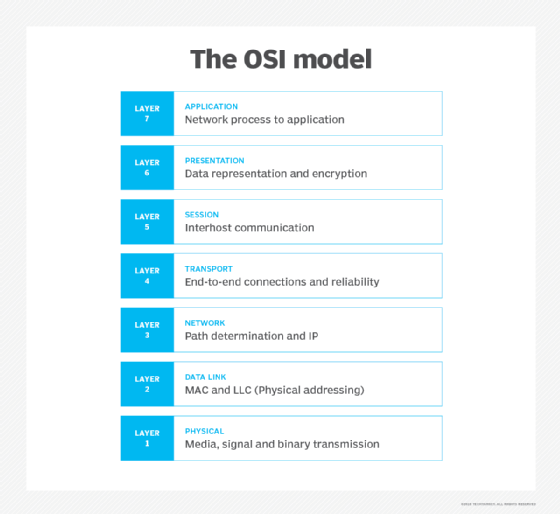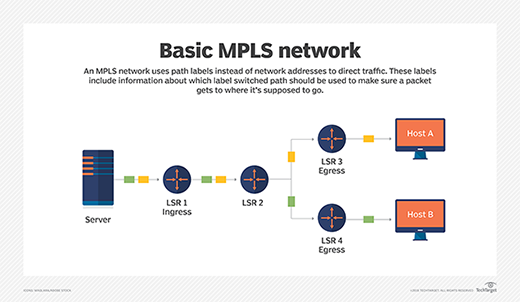GMPLS (Generalized Multiprotocol Label Switching or Multiprotocol Lambda Switching)
What is GMPLS (Generalized Multiprotocol Label Switching)?
GMPLS (Generalized Multiprotocol Label Switching) is a networking technology that enables fast and reliable network switching of data flows on any type of network infrastructure. GMPLS extends Multiprotocol Label Switching (MPLS) by adding support for time-division multiplexing (TDM), optical fiber switching, Layer 2 switching, and optical wavelength switching, in addition to packet-based switching.
GMPLS was developed to extend the benefits of MPLS to any type of network. It enables participating routers and switches to quickly make decisions on how to forward data based on how it is received instead of performing processing-intensive IP-based routing. It also enables link management, failover redundancy and quality of service.
Request for Comments 3945 standardized GMPLS in 2004. It incorporates the functionality developed for Multiprotocol Lambda Switching.
How does GMPLS work?
GMPLS speeds up data flow by determining the path that the data will take as soon as the data is ingested into the network at the ingress point. This happens at a label edge router, which determines the path that the data takes through the network to the exit or egress point label edge router.
These paths are called labeled switched paths (LSPs). It makes this decision based on the characteristics of the ingress interface. The following are the LSP selection criteria in GMPLS:
- TDM links are identified by time slot.
- Wavelength (lambda) division multiplexing links are identified by wavelength.
- Fiber optic and copper links are identified by fiber strand or port.
Once the label edge router identifies the correct LSPs, the data is sent out through the correct interface. The data may then traverse the network and be switched by label switched routers before reaching the exit, or egress, label edge router.
GMPLS in optical networks
The use of GMPLS greatly benefits primarily fiber optic networks.
GMPLS supports many parallel links simultaneously. This enables many wavelengths or large optical fiber bundles to be supported.
Since GMPLS is primarily concerned with the interface of the data instead of the content of the data, it enables the separation of the control plane (signaling) and the data plane (transport). Because of this, most wavelength switched optical networks use GMPLS as the default control method.
In this way, GMPLS runs on a separate network that controls the optical cross-connects that perform the optical data transmission through routing the correct LSP.
Comparing MPLS and GMPLS
MPLS and GMPLS are closely related in function. This makes sense as GMPLS was developed as a way to extend the same types of benefits of MPLS to more network types than are supported by MPLS. In order to support these different media types, though, GMPLS made several key changes to the MPLS standard.
MPLS and GMPLS similarities
Both MPLS and GMPLS enable more efficient routing of data than traditional IP-based routing. In IP routing, each router needs to inspect the data to determine how to route it.
The routing also occurs at the routing layer, Open Systems Interconnection (OSI) Layer 3. MPLS and GMPLS enable the data flow to be determined at the data entry point. They forward the data on the switching layer, OSI Layer 2.
They are, therefore, appropriately called switching technologies, instead of routing. Since the switching happens at a lower layer and is pre-computed, the traffic can be sent faster than when IP routing is used.

MPLS and GMPLS use LSPs to define the connections between devices. The LSP is predetermined and can be set up as part of the configuration or from a signaling protocol.
Because LSPs are preconfigured, this enables decisions to be fast and simple for intermediary routers. This combines aspects of switching (Layer 2) and routing (Layer 3), so they are sometimes referred to as Layer 2.5 protocols.

MPLS and GMPLS differences
There are many differences between MPLS and GMPLS. They are not interoperable out of the box. These changes were necessitated to support the different underlying network connections. MPLS only supports discretely sized data payloads, which includes IP data packets and Asynchronous Transfer Mode data cells.
This is because it requires adding additional data to the packet header. It cannot support streaming data interfaces. GMPLS supports discretely sized data and data streaming interfaces, including fiber switching, Layer 2 switching, wavelength (lambda) switching and TDM.
GMPLS does not require adding a label header and can instead use an inferred label determined by the characteristics of the interface.
MPLS supports more signaling and routing protocols. MPLS supports Intermediate System to Intermediate System and Open Shortest Path First Traffic Engineering (OSPF-TE) routing. It may also use Label Distribution Protocol, Resource Reservation Protocol Traffic Engineering (RSVP-TE) or Border Gateway Protocol for signaling.
GMPLS only supports OSPF-TE for routing and RSVP-TE for signaling.







